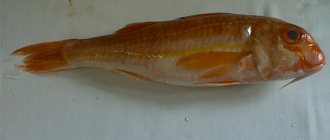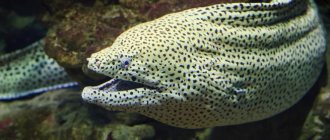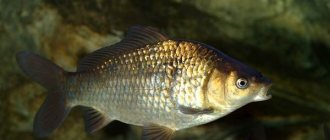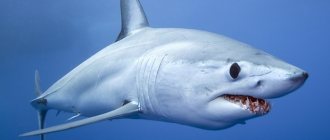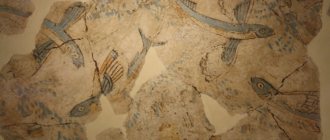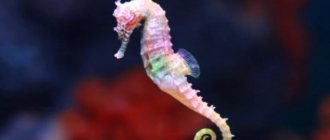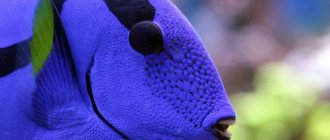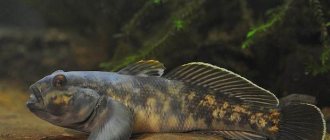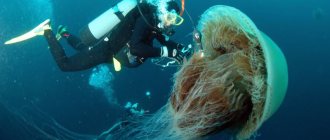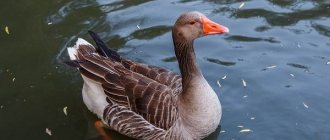The Red Sea, one of the saltiest seas in the world, is very rich in diverse fauna. About 1.5 thousand species of fish that live in this sea have been studied. The diverse fauna attracts tourists from all over the world. By looking at photos of Red Sea fish, you can be convinced of the diversity of the inhabitants of the sea.
This article tells you which fish in the Red Sea can be dangerous to humans. Listed below are the main varieties of Red Sea fish with photos and names that can be found along the entire Red Sea coast.
Red sea sharks
These Red Sea fish are divided into pelagic and coastal. The former prefer the open sea. Pelagic sharks approach the shores only on islands with steeply sloping reefs. Coastal sharks, on the other hand, rarely enter the open sea.
Coastal sharks of the Red Sea
The coastal species includes the nurse shark. Its name comes from the friendliness of the fish. It belongs to the family of baleen sharks. Two outgrowths are located on the upper jaw. This prevents the nanny from being confused with other sharks. However, in troubled water there may be parallels with representatives of the tiger species.
Nurse sharks do not live at depths of more than 6 meters. At the same time, some individuals reach 3 meters in length.
You can distinguish a nanny from other sharks by the presence of outgrowths near the mouth
Blacktip reef sharks also stay off the coast. Their length rarely exceeds 1.5 meters. Blacktip sharks belong to the gray shark family. The species name refers to the black markings on the tips of the fins.
Blacktip sharks are shy, cautious, and not prone to attacks on people. In extreme cases, in defense, the fish would bite the divers' flippers and knees.
There is also a whitetip reef shark in the Red Sea. It can be longer than 2 meters. On the gray fins of the fish, the spots are already snow-white.
The silvertip shark also has white markings. However, its second dorsal fin is smaller than that of the whitefin, and its eyes are round instead of oval. The gray reef shark is also found off the Red Sea coast. The fish has no markings. The length of the animal reaches 2.6 meters.
The gray reef shark is aggressive and does not like curiosity or attempts at contact from divers. The tiger shark is also found off the coast. Representatives of the species are aggressive and large - up to 6 meters in length. The weight of the animal is 900 kilograms.
The names of Red Sea fish are often based on their colors. This also applies to the tiger shark. Belonging to the gray family, it has brownish spots on its back. For them, the species is also called leopard.
Another representative of the coastal fauna of the Red Sea is the zebra shark. It can be more than 3 meters, but is peaceful. The zebra shark is elongated, graceful, and black and white striped. Hammerhead, silver and sand sharks are also found off the sea coast.
Pelagic sharks of the Red Sea
Pelagic species include: oceanic, silky, whale, white and mako sharks. The latter is the most aggressive and insatiable. The length of the fish exceeds 3 meters. There are 4-meter individuals.
The second name for mako is blacknose shark. The name is due to the coloring. The darkened snout is elongated. Therefore, two subspecies are distinguished. One of them is long-snouted, and the second is short-snouted.
Mako is one of the most dangerous sharks in the world
A giant hammerhead shark is still swimming far from the shores. Unlike the coastal one, it can be longer than 6 meters. The giant hammer is an aggressive species. Cases of fatal attacks on people have been recorded.
In the Red Sea, the temperature is comfortable for the giant hammerhead shark. However, the fish is also tolerant of cool waters. Sometimes molotovs are found even in the seas of the Primorsky Territory of Russia, in particular in the Japanese Sea.
Diseases and prevention
The red parrot fish has a strong immune system, but still sometimes gets sick, as can be seen:
- along blackened fins;
white lumps on top of the scales (semolina disease) or fins (ichthyophthyriosis disease), treated with the drug “Sera costapur”;
- by lying on the ground for a long time;
- spitting food;
- by white stools;
- by wounds.
The main causes of disease include contaminated water, overcrowding or contamination from diseased fish.
Black spots
The appearance of black spots on the body, which appear and then disappear for no reason, is associated with stress in the fish. Parrots do not like changes, and if the situation has changed, it is already stressful for them.
Another cause of stains is ammonia burn.
Other diseases
If your red parrot is covered with pale spots and its color has faded, it is worth checking the water for the presence of nitrates. Perhaps the fish was poisoned. It is necessary to replace the water and calcinate the soil. The disease goes away in 3 days.
In the case of hexamitosis, the stool changes color and becomes tear-like. The fish loses its appetite and redness or spots appear on its fins. It floats in the upper layer of water, closer to the surface, because the water is poor in oxygen. Frequent changes of water with the addition of hydrogen peroxide, non-concentrated potassium permanganate or a specially purchased product will correct the situation.
Red Sea Rays
These predatory fish of the Red Sea are the closest relatives of sharks. Stingrays are also chordates. In other words, the fish skeleton is devoid of bones. Instead of them - cartilage.
The stingray community is divided into two groups. One contains diamond-bodied stingrays. Another order includes electrical species.
Red Sea diamondback rays
The order Stingrays are divided into three families. All are represented in the Red Sea. The first family is eagle rays. They are pelagic. All eagle eagle are gigantic, distinguished by a clearly defined head and interruption of the pectoral fins at eye level.
Many brackens have something like a beak. These are the connected edges of the pectoral fins. They are fused under the top of the snout.
The second family of diamondback rays are stingrays. Their bodies are equipped with small spines. There are one or more large ones on the tail. The maximum needle length is 37 centimeters.
Stingrays are poisonous fish of the Red Sea . The tail spines contain channels through which the toxin flows. The stingray attacks in the manner of a scorpion. When the poison enters the body, blood pressure drops, tachycardia occurs, and paralysis is possible.
The last family of the rhombic order is called Rokhlev. They are easily confused with sharks, since the body of the fish is slightly flattened. However, the gill slits in rochlevs are located at the bottom of the body, like in other stingrays. Stingrays swim using their tail. Other stingrays move mainly with the help of their pectoral fins.
The stingray is easily confused with a shark due to its spiked tail.
Electric Rays of the Red Sea
There are also three families in the detachment. Representatives of all are often brightly colored, have shortened tails and rounded bodies. On the sides of the fish's head are paired electrical organs. The discharge is produced after an impulse from the stingray's brain. The first family of the order is the stingrays. In the Red Sea it is represented as marbled and smooth. The latter is considered ordinary.
The second family of electric stingrays in the pond are daffodils. These are slow, bottom-dwelling fish. They do not descend to a depth of more than 1 thousand meters. Often, daffodil rays are found in sandy bays and coral reefs.
Narcinoid rays produce electricity with a power of up to 37 volts. Such tension is not dangerous for a person, although it is painful.
There is also a family of sawfish in the order of electric stingrays. In the photo, the Red Sea fish look more like sharks and have bony outgrowths on the sides of their heads. The outgrowths fix the strongly elongated snout. Essentially, we are talking about sawfish.
Aggressive little fish
Fish that live in large numbers in shallow waters cause great admiration for inexperienced swimmers. Bright fish, which seem so harmless, are considered especially beautiful. Often it is small fish that are dangerous, as they can pierce the enemy’s skin or release poison. In any case, you need to be vigilant. The inhabitants of the Red Sea have an unpredictable character and deceptive appearance.
Poisonous cylinder
When in danger, the balloon fish inflates and increases in size several times. The poison of this individual is very dangerous, and although it does not attack humans, it is better not to approach it. Balloon fish are protected with needles that are filled with toxins. It is from balloon fish that the famous dish - fugu - is prepared. Only an experienced chef can prepare this dish, because with the slightest mistake, the cooked fish can kill a person.
In times of danger, the balloon fish inflates and increases in size several times.
sea butterfly
Refers to the indigenous inhabitants of this sea. Fish of the Red Sea can be migratory, which are also found in other bodies of water, but the Sea Butterfly lives only in this place; it is impossible to meet it in another body of water.
It is distinguished by an unusual manner of movement: it lowers its nose down, resembling an antenna with its fin. It has a bright yellow color and moves in a flock, living in the depths.
Clown (Amphiprion)
The fish of the Red Sea are different, for example, the clown fish combines small size and pronounced aggression. The tiny inhabitant of the pond is not afraid of anyone. At least it attacks swimmers quite often. The clown does not pose any great danger , but it can bite your finger - this is not a pleasant sensation.
Clown fish attacks swimmers quite often
The clown fish acts as a protector, driving away opponents from the anemone. And since the anemone, the fish’s home, is located in shallow water, meeting people occurs quite often.
Parrotfish and Imperial Angel
You can often notice that the names chosen for the fish are appropriate and accurately describe their appearance. Sometimes they emphasize similarities with land-based faunal brethren. So the parrot fish got its name for its similarity in color to a feathered fish. In addition, the fish's mouth resembles a beak, with which it likes to eat corals. Very often it can be seen near reefs.
The imperial angelfish is considered the most beautiful fish in the southern seas. The unusual color, which contains yellow, blue and white shades, can have various combinations. The colors merge into stripes, which can be narrow and wide, whole and interrupted, all shades together or only part of them - such a varied and recognizable imperial angel.
Wrasses of the Red Sea
Wrasses are a large family of 505 species. They are divided into 75 genera. They are represented by both miniature fish several centimeters long and giants 2.5 meters long and weighing about 2 centners.
All wrasse have an elongated, oval-shaped body covered with large and dense scales. Another difference is the retractable mouth. He looks small. But the lips of fish are large and fleshy. Hence the name of the family.
In the Red Sea, wrasse are represented, for example, by Napoleon fish. This is a 2-meter, good-natured representative of the ichthyofauna. On the forehead of the fish there are skin outgrowths that resemble a cocked hat. This is what Napoleon wore. Hence the name of the fish.
You can meet an individual wearing a cocked hat near the coastal reefs. The large fish of the Red Sea have equally impressive intelligence. Unlike most of their relatives, Napoleons remember the people they met and came into contact with. Contact often involves pushing the diver's hand as if asking for a stroke.
Camouflage specialists
A hidden threat lies in the areas designated as beach areas. There are fish that live there and can mix with their environment. One of these inhabitants is the warty fish, or stone fish, which takes on the shape of a cobblestone and can cause serious harm to health.
Resembling a stone overgrown with algae, this predator attacks with strong poison, piercing the enemy’s skin with sharp needles. The venom of a wart is much stronger than that of a cobra , and the particular danger lies in the fact that the fish likes to live in coastal areas. Even the most durable swimming shoes will not save you from its needles - the wart penetrates any protection.
Another master of camouflage is the devil fish. It grows only up to 35 centimeters, but blends perfectly with any surrounding landscape. A very ferocious and poisonous inhabitant of the sea, posing a threat to scuba divers, who often die from its poison.
These are the fish found in the Red Sea. The inhabitants of this reservoir are good at camouflage, so some caution should be exercised. It is especially dangerous to be near reefs where a variety of predators hide.
Red Sea Perches
The reservoir contains mainly rock perches. They are named so because they stay near the bottom, masquerading as the stones lying on it, hiding between them. Rockfish are members of the Seranoceae family.
It contains more than 500 species of fish. Most live at depths of up to 200 meters, have large and sharp teeth, and spiky fins. In the Red Sea, known for its abundance of coral reefs, groupers include:
Anthias
Because of their miniature size and brightness, they are called fairy perches. They are popular among aquarists and often decorate photos taken underwater. Anthias, like most rockfish, are protogenic hermaphrodites.
Pisces are born female. The majority of individuals remain them. A minority transform into males. They recruit harems for themselves. According to some reports, there are up to 500 females in them.
Groupers
Their upper lip is fixed to the head by skin ligaments. When the lower jaw drops, the mouth becomes tube-shaped. This helps, like a vacuum cleaner, to suck in crustaceans - the main food of groupers.
Wandering grouper can be found far from the shores of the Red Sea. Its length reaches 2.7 meters. With such a size, the fish poses a danger to scuba divers and is capable of sucking them in like crustaceans. This can happen by accident, since groupers do not intentionally display aggression towards humans.
Barracudas
Eight of the 21 known species are found in the Red Sea. The largest is the giant barracuda. It reaches a length of 2.1 meters. Fishes of the order Perciformes resemble river pikes in appearance. The animal has a massive lower jaw. She is pushed forward. The mouth contains large and strong teeth. Several more rows of small and sharp ones are visible from the outside.
Butterfly fish
They belong to the shield-toothed family. The name refers to the shape and size of the teeth. They are located in a miniature, retractable mouth. Butterflies are also distinguished by an oval body, strongly compressed from the sides. Butterflies are endemic to the Red Sea. Fish abound in it, but are not found outside the reservoir.
Parrotfish
They represent a separate family of the order Perciformes. Parrotfish have fused incisors. They form a kind of beak. The jaws of fish are folded into two plates. There is a seam between them. This helps in nibbling coral. The algae is eaten off of them.
The fish seem to absorb the color of the corals. The brightness of underwater inhabitants is another reason to call them parrots. Unlike adults, young parrotfish are monochromatic and dull. With age, not only colors appear, but also a powerful forehead.
Popular and safe fish
A visit by tourists to popular resorts is not complete without scuba diving and sea fishing. Famous representatives of the water depths will leave a vivid impression:
Parrot fish
The name corresponds to its bright appearance: multi-colored coloring and a growth on the forehead like a bird’s beak. Blue-green, yellow, orange-red in color, large fish (up to 50 cm in length) are safe.
But an accidental bite from the powerful jaws can be quite painful. At night, the fish forms a jelly-like cocoon - protection from parasites and predators. Even the hypersensitive moray eel cannot find it by smell.
Fish-Napoleon
The growth on the head, similar to the emperor’s cocked hat, gave the species its name. The impressive size of the Maori wrasse (up to 2 meters long) is combined with a good nature and trusting character. The fish is so sociable that it itself swims up to the drivers to get to know each other better.
Napoleon fish is often called sponge fish
Antais
A schooling fish of very small size (7-15 cm). The inhabitants of coral reefs have bright colors of orange, green, and red. Up to 500 fish can gather in a school.
Bistriped amphiprion
The bright, unusual coloring with stripes outlined in black on an orange background attracts photographers. The fish live in pairs in sea anemones and are not at all afraid of scuba divers.
The tentacles of sea anemones, which are poisonous to others, do not harm the settlers, covered with protective mucus, as if protecting them. Amphiprions are sometimes called clowns. They behave bravely near their shelter.
Clown fish seek protection in sea anemones, which are poisonous to other aquatic life.
Butterfly fish
The beauty is easy to recognize by its tall, strongly flattened oval body with a long dorsal fin and bright black and yellow color. Due to their diurnal lifestyle at shallow depths, they have been well studied by masked divers.
They live with small flocks and pairs. There are color options of blue-orange, black-silver, red-yellow.
Black-spotted Grunt
For her wide lips she is nicknamed sweetlip. The names of the fish of the Red Sea are often telling, so the color of the fish and the grinding sound when biting through the coral determined the name of the inhabitant.
Lethrina
Inhabitants of the sea coastline. They feel great among rocks, reefs, rich in vegetation. Greenish-brown in color with dark spots on the sides. The fins and interorbital space are red-pink. Body length up to 50 cm.
Imperial angel
It’s hard not to notice the fish even among other beauties of the warm sea. Decorated with frontal and ocular stripes. Color from yellow-blue-white range in variations of shades and patterns. A variety of solid and interrupted stripes, spots, specks, transitions and mergers.
The directions of the pattern are also varied: circular, diagonal, vertical, transverse, wavy. Despite all the individuality of the fish's outfits, they are recognizable in their grace.
The imperial angel has a variety of colors
Plataxes
Young sickle-shaped fish grow up to 70 cm in length. The body is flattened on the sides. The color is bright orange or yellow with three black stripes. Curious by nature, not shy, they swim quite close to the drivers. Stay in groups. With age, the color becomes uniformly silvery as the stripes blur. The size of the fins decreases.
Lantern fish
The luminous organs most often are the eyes. The emission of greenish light comes from the lower eyelid, sometimes from the tail or abdominal part. Small fish, up to 11 cm, live in caves at depths of up to 25 m. They hide from divers. Light attracts prey to them and serves as a contact for their species.
Triggerfish of the sea
They belong to the order Pufferfish. It also includes sea urchins, sunfish and sawfish. They also live in the Red Sea. However, if the files and moons move away from the shores, the triggerfish stay close. Species of the family are distinguished by a fin hidden in a skin fold on the back. It extends when the fish sleeps. She hides between the corals. The fin helps to stay in the shelter.
Rhinecantes Picasso
Found only in the Red Sea. What kind of fish do they look like? Tall, elongated and flattened laterally. The head is like a triangle. The eyes are set high, connected by blue-blue stripes extending to the gills. The body of the fish is oval. The caudal peduncle is decorated with three black lines. One line extends from the mouth to the fins on the chest. The back of the fish is olive and the belly is whitish.
Rhinecanths are the smallest of the triggerfish. The nuances of Picasso's appearance may vary depending on the type. Some live outside the Red Sea, such as the Indo-Pacific region.
Giant triggerfish
Otherwise called titanium. In the triggerfish family, the fish is the largest, exceeding 70 centimeters in length. The weight of the animal reaches 10 kilograms. Titans are dangerous fish of the Red Sea . Animals pose a danger during mating and raising offspring.
For eggs, giant triggerfish dig nests at the bottom. Their width reaches 2 meters, and their depth is 75 centimeters. This territory is actively defended. Approaching divers are attacked by biting. Fish have no poison. However, triggerfish bites are painful and take a long time to heal.
Interesting, unusual, funny facts about this fish
Names of this fish in other languages:
- Spanish - fredi;
- French - girelle paon;
- Albanian - vladika;
- Latin - thalassoma pavo.
In preparation for sleep, the peacock thalassoma secretes mucus from its mouth containing antibacterial substances and gradually envelops the fish. The salivary membrane is useful: it hides the smell from predators, protects against blood-sucking parasites and charges the fish with positive electrolytes. Serves as a kind of “protective bag”. Watch in a short video the formation of a mucous cocoon
And also, the parrot fish is naive, you can make a trap for it, the same one every day and every time it will fall into it.
Red Sea Angelfish
They belong to the genus Pomacanth. All its representatives are miniature. Let's start with the biggest one.
Yellow-striped Pomacant
Large representatives of the species weigh about 1 kilogram. Yellow-striped individuals descend to significant depths, often choosing steeply sloping reefs. Yellow-striped fish are called because they have a vertical line in the middle of their body. It is wide and bright yellow. The rest of the body is painted in blue-green tones.
Emperor angelfish
This pomakant is medium in size, up to 35 centimeters in length. The body of the fish is colored blue. There are yellow lines on top. They are located horizontally or at an angle. A brown stripe runs through the eyes.
The head is separated from the body by a bright blue “field”. The anal fin is the same color. The tail is almost orange. Colorfulness worthy of an angelic creature. The Imperial Angel is a favorite among aquarists. One individual needs 400 liters of water.
Imperial angel
The imperial angel is a very beautiful fish that inhabits coral reefs. The color is blue or dark blue with alternating yellow and white stripes of different shapes. It reaches a length of up to 40 cm. Such fish are often kept in aquariums. Fish does not pose a danger to humans.
Anglerfishes of the Red Sea
The detachment consists of 11 families. Their representatives have luminous organs. They are found near the eyes, ears, anal fin, on the tail and under it.
Indian lantern fish
Her luminous organs are located on the lower eyelid. Energy is produced by symbiotic bacteria. The light attracts zooplankton, a favorite delicacy of lanterns. The Indian lantern fish is miniature, not exceeding 11 centimeters in length.
The species is the only anglerfish common in the Red Sea. By the way, the fish of this order are called anglers because of their luminous head organ. In species that have it, it is suspended on a thin and long outgrowth, reminiscent of a float on a fishing line.
Content
- 1. General description of parrot fish
- 2. Distribution and habitats of parrot fish
- 3. Age and size
- 4. Lifestyle
- 4.1 Reproduction - time and characteristics of spawning
- 4.2 Diet - what to eat
- 5.1 Biting calendar - what time of year is the best time to bite?
- 5.2 In what weather does parrot fish bite best?
- 5.3 What are the best places to fish?
- 5.4 What gear is best to fish with?
- 5.5 Bait for parrot fishing
- 5.6 What baits and baits to fish with
- 5.7 How parrot fish bite
- 5.8 How to catch correctly - Basic techniques
- 5.9 Highlights
Scorpionfishes of the Red Sea
More than 200 species of fish belong to scorpionfishes. The order is called warts. The fish included in it can survive for 20 hours without water. It is not recommended to touch even weakened individuals. The body of the fish is equipped with poisonous spines.
Stone fish
The fish got its name because its body surface imitates a stone. In order to blend in with the boulders, the animal lives at the bottom. Those same warts help you blend into the bottom landscape. There are a lot of growths on the body of the stone. Additionally, the fish matches the color of the bottom boulders. The stone is the most poisonous fish in the Red Sea.
Some individuals reach a length of 50 centimeters. The wart, like other fish of the Red Sea, “tastes” its saltiness. It is larger than in other seas. The point is accelerated evaporation.
The Red Sea is shallow and sandwiched between continental lands. The climate there is tropical. When combined, these factors contribute to active evaporation. Accordingly, the concentration of salt per liter of water increases.
Compatibility with other fish species
Parrot fish live peacefully with many species of their fellows. Both large peaceful fish and some representatives of the predatory world can get along well with them.
Parrots are not averse to eating small fish, so it is not recommended to house them with neons and gracilis. But the proximity of arowanas, labeos, blacklegs, medium and large catfish, barbs is quite suitable for parrot fish.
Features of character and lifestyle
Photo: Parrot fish
The fish's lifestyle is mostly solitary. He tries to stay in “his” area, not far from his shelter, so that in case of danger he can hide in his house. Such places are located near coral reef gorges and caves. And it does not leave its habitat, since all the main food is available on the reefs.
As soon as night falls, the parrot fish secretes mucus around itself from its mouth, which forms a special protective film. This protection prevents the smell emanating from the fish from spreading and being detected by predators that hunt at night using their sense of smell. This method also helps to heal wounds that appear in fish from reefs, since the mucus has an antiseptic effect.
The fish spends up to 4% of its total energy on this procedure throughout the day. Such protection does not allow other blood-sucking parasites, such as isopods, from groups of crustaceans, to approach. To circulate water in the cocoon, the fish leaves holes on both sides, allowing water to pass freely. At dawn, she chews through this film with her sharp teeth and goes in search of food.
An interesting feature is that one parrotfish can produce up to 90 kilograms of sand annually due to its unusual diet.” As mentioned above, stones and pieces of coral, when they get into food along with algae, come out of it in the form of crushed sand. Such delicate and fine sand can be found on the shores of seas where parrotfish live.
What does parrot fish eat?
Photo: Blue Parrotfish
Parrotfish are herbivores. Coral polyps and algae are preferred as main dishes. They scrape young algae plants from dead coral substrates, and small pieces of coral and stones fall along with the vegetation into the stomach. But this is even good for fish, as it improves digestion. After digesting the marine invertebrates, the fish excrete them as sand, which subsequently settles on the seabed.
Parrot fish save corals from death and suffocation by scraping young algae from coral reefs and also eating decomposed worms, mollusks, plants, sponges, etc. This process is called bioerosion. Because of this, they were called coral reef orderlies.
They like to eat in lagoons. It is there that there are a large number of fish’s favorite delicacies. They try to get there when the tide comes in. Some species of parrotfish, of which there are more than 90 species, feed on a variety of mollusks and other bottom-dwelling animals that live in the depths of the sea.
Social structure and reproduction
Photo: Parrotfish
During spawning periods, parrotfish gather in schools. In a flock there will always be one or two dominant males and several females. “But it happens that there is no male in the flock, and then a moment comes when one female, most often the oldest in the flock, has to change sex - to become a hermaphrodite.”
The gender reassignment process takes several weeks. Thus, the parrotfish becomes a hermaphrodite. Hermaphrodites are individuals that are capable of developing both eggs and sperm. This process can occur in a fish several times throughout its life. With the exception of one type - marble. This species does not change its sex.
After spawning, the eggs are fertilized by the male, and then carried into the lagoons by the current. The development of eggs occurs within a day, the fry appear, where they are in relative safety in the depths of the lagoon. This is where the larvae grow and feed on plankton.
As the fish grows from a fry to an adult, it goes through 2-3 stages where they change their color. The fry have a uniform color, with small stripes and specks. In immature individuals, purple, red or brown colors predominate. And the adult individual is already distinguished by bluish, green, and purple hues. Throughout its life, a parrot fish can change its color more than once.
As soon as the fry emerge from the larvae, they head to the coral polyps, where the main food is young algae. There they find shelter for themselves. The lifespan of a parrot fish in its natural habitat is approximately 9 - 11 years.
